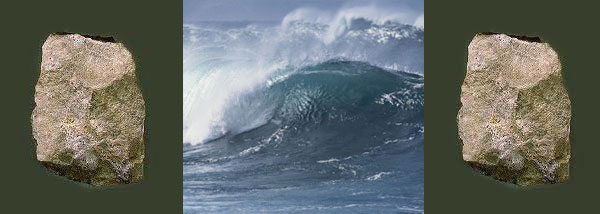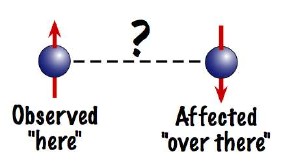Spooky Action at a Distance
by Andrew Boyd
Today, we get spooky. The University of Houston's College of Engineering presents this series about the machines that make our civilization run, and the people whose ingenuity created them.
Imagine a science fiction film with the following scene. Our hero is holding a rock. He closes his eyes and throws it. Instantaneously, it morphs into a giant wave. But when our hero opens his eyes and looks, it immediately turns back into a rock.

It's actually not science fiction. When physicists throw particles like photons or electrons, that's exactly how the particles behave. It's one of the great mysteries of quantum mechanics. A thrown particle behaves like a wave. But when we observe it we find a particle. Under what's known as the Copenhagen Interpretation, the act of observation actually causes the wave to collapse into a particle.
Einstein couldn't accept that. And in 1935 he and coauthors Podolsky and Rosen proposed a now famous thought experiment. They first observed that pairs of particles can become intertwined in a state known as quantum entanglement. Photons, for example, have a property called spin. Spin can be either left-handed or right-handed. When an entangled pair of photons is created, we know that one will have left-handed spin and the other right-handed. But we don't know which will have which until we look.
Suppose, wrote the three physicists, we throw two entangled photons in opposite directions, letting them travel to opposite ends of the galaxy. Next, we observe one photon and determine its spin. Because the pair is entangled, our action has caused the distant photon to take on the opposite spin.
It's important to emphasize that under the Copenhagen Interpretation we don't discover the first photon's spin and thus discover the other photon's spin. When we observe the first photon we cause its spin to exist, and thereby cause the distant photon's spin to exist as well. Einstein called this "spooky action at a distance." How could doing something here cause something to happen instantaneously on the other side of the galaxy?

The Einstein-Podolsky-Rosen paper made waves in the physics community for decades. Schrödinger, a fierce supporter of the Copenhagen Interpretation, was moved to conclude that "measurements on separated systems cannot directly influence each other — that would be magic."

Yet, when the dust settled, this "magic" no longer seemed so magical. The jury's still out on the Copenhagen Interpretation, but not because of spooky action at a distance, which today is routinely accepted. Thanks to quantum entanglement, what we do here can make something happen over there — at least in the realm of the very small. The question is, what do we do with this knowledge? Quantum computing. Quantum teleportation. Physicists certainly have plenty to keep themselves busy.

I'm Andy Boyd at the University of Houston, where we're interested in the way inventive minds work.
Notes and references:
For related episodes, see The Bohr-Einstein Debates and Determinism and the Many Worlds Interpretation.
The Einstein-Podolsky-Rosen Argument in Quantum Theory. From the Stanford Encyclopedia of Philosophy Website: http://plato.stanford.edu/entries/qt-epr/. Accessed July 5, 2011.
M. Kumar. Quantum: Einstein, Bohr and the Great Debate about the Nature of Reality. New York: Norton, 2008.
The D-Wave Systems logo is taken from pictures made available by the company for press use. All other pictures are from U.S. government Websites.